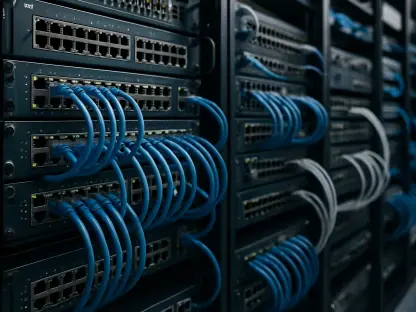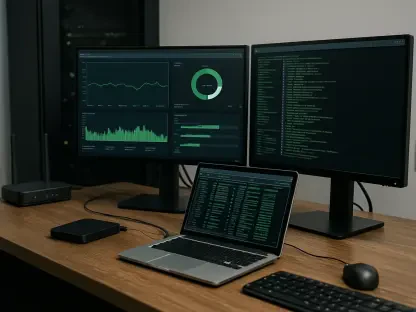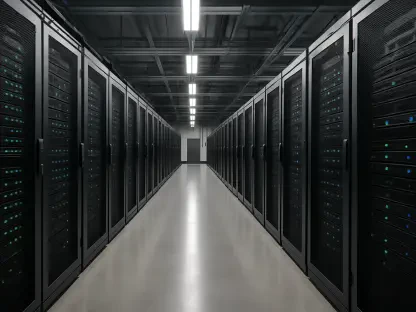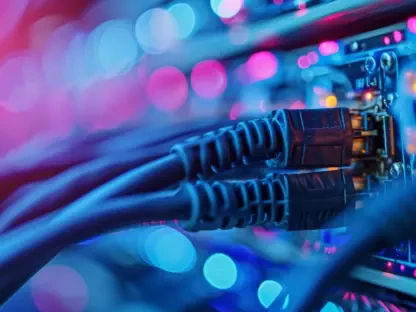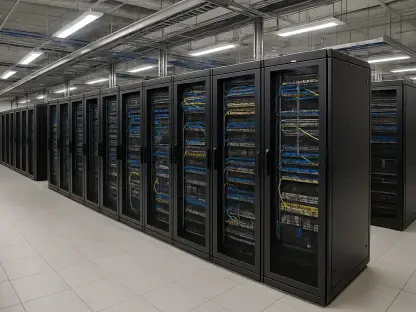As digital transformation accelerates, network engineering faces unprecedented challenges like complexity, scale, and the need for real-time responsiveness. Traditional methods cannot keep pace, prompting an urgent search for innovative solutions. This setting becomes even more complex as global networks expand, requiring sophisticated approaches for resilience and management. Enter AI into the fray, introducing a transformative layer to network engineering. This avant-garde shift toward self-healing networks, made possible by artificial intelligence, presents intriguing possibilities. By automating mundane processes and dynamic responses, AI is reshaping how these systems are managed. Industries are beginning to experience a tangible shift in how network reliability and efficiency are addressed, thanks to advancements in AI-powered innovations within network engineering.
Emergence of Self-Healing Networks
Advantages of AI Integration in Networks
In recent years, the prospect of networks self-healing with minimal human intervention has gained traction. The integration of AI into network ecosystems allows for automated detection and correction of anomalies that can otherwise lead to significant disruptions. This technology not only improves operational efficiency but also bolsters cybersecurity measures, reducing the window of vulnerability. AI systems possess the ability to swiftly analyze data trends, identifying irregularities faster than human operators can. This enhances proactive management and reduces downtime—a critical advantage for businesses reliant on uninterrupted network services. Furthermore, AI-assisted networks offer the scalability needed to handle increasing data volumes without manual oversight, a necessity in today’s interconnected world.
The Model Context Protocol
At the heart of AI’s transformation of network engineering lies the Model Context Protocol (MCP). This advanced protocol facilitates AI’s understanding of network-level languages, enabling nuanced interactions within digital infrastructures. MCP empowers AI agents to autonomously navigate network operations, addressing issues like configuration drift—a phenomenon where network settings inadequately align with the intended configuration due to accidental deviations. By monitoring changes against a set baseline, these agents can dynamically adjust configurations, ensuring coherence and consistency without human intervention. This autonomy highlights AI’s capability to not only detect but also rectify deviations, making MCP a cornerstone of self-healing networks. As these systems evolve, MCP’s role will likely grow in importance, emphasizing its value in future network management models.
Practical Applications and Demonstrations
AI’s Role in Network Troubleshooting
Demonstrations of AI’s role in managing network integrity provide insight into its practical applications. In one instance, AI agents like Network Pharaoh operate within the Splunk Enterprise framework, utilizing natural language processing to analyze logs comprehensively. This facilitates the identification of configuration changes—a process critical to maintaining network stability. Through a conversational interface, Network Pharaoh can perform advanced reconnaissance to detect anomalies, ultimately leading to automated corrective action. This capability underlines how AI can streamline troubleshooting processes, significantly reducing human workload and enhancing system reliability. Operators benefit from reduced manual oversight, lessening errors and improving response times in network maintenance tasks.
The Meraki Dashboard and Autonomous Correction
Further exemplifying the self-healing capability is the integration of AI with Meraki’s dashboard, showcasing how autonomous correction works. Upon detecting a configuration drift, such as an unexpected IP address change, AI utilizes the Meraki API to reverse these alterations autonomously. This process requires no pre-programmed responses, demonstrating AI’s ability to adapt dynamically to real-time challenges. By reinstating preferable settings, AI agents minimize risks associated with non-compliance, potential downtime, and unnecessary manual intervention. This autonomous feature emphasizes its strengths in mitigating disruptions that can affect business continuity and compliance, offering a seamless interface where AI efficiently manages network corrections.
Skills Essential for Harnessing AI
Mastery in Coding and Frameworks
The transformative potential of AI in network engineering demands specific skill sets from professionals. A foundational requirement is proficiency in coding, particularly Python, which serves as a primary language for scripting and developing network automation solutions. Expertise in using Software Development Kits (SDKs) is equally crucial as they enable AI integration and enhance application functionalities. Moreover, MCP framework knowledge allows for coherent deployment of AI models within network systems, emphasizing the need for comprehensive training. Network engineers must acquire a blend of technical skills and strategic insights to architect effective AI-driven systems, ensuring seamless integration and optimal performance within digital landscapes.
Network Automation and Intelligence
Emphasis on network automation principles is essential to leverage AI’s capabilities in engineering contexts. This entails understanding the intricacies of machine learning algorithms and their application within autonomous network systems. Engineers must develop a robust grasp of both foundational networking and the intricacies of AI-driven dynamics to efficiently manage contemporary digital ecosystems. Building these competencies is crucial, as engineers must develop intelligent design solutions that align with evolving network demands. This skill set becomes a vital tool for navigating the complexities of self-healing network architectures, reinforcing AI’s role in driving efficiency and reliability across diverse industry setups.
Visionary Strides Toward Agentic Networks
Cisco’s Strategic AI Canvas Initiative
Cisco’s vision for agentic networks reveals the company’s strategic pursuit to redefine traditional practices through AI-driven insights. The AI Canvas initiative embodies modular agents equipped with situational intelligence derived from Cisco’s extensive Deep Network Model, synthesizing years of telemetry and experience into sophisticated network understanding. This framework heralds a future where AI agents perform complex tasks autonomously, from resolving VLAN misconfigurations to addressing segmentation challenges—all while ensuring uninterrupted business-critical traffic. Cisco’s strategic approach places AI at the helm, pushing boundaries to orchestrate seamless networks that anticipate and respond to dynamic changes.
The Deep Network Model
The Deep Network Model serves as a pivotal force in Cisco’s AI strategy, encompassing vast datasets and expert knowledge to furnish AI agents with unrivaled network intelligence. By harnessing comprehensive telemetry, Cisco empowers agents to operate with precision, analyzing real-time data to execute decision-making processes fluidly. This model underscores AI’s potential in modifying traditional network systems, pivotal for modernizing how networks are monitored and corrected. As AI technologies continue to integrate into everyday network operations, Cisco’s Deep Network Model will remain a central element, redefining the scope and scale of network management practices.
Implications for Network Engineering Practices
Transition to AI-Driven Solutions
The transition to AI-driven solutions in network engineering represents a fundamental shift, promising significant enhancements in efficiency and reliability. As AI-powered tools become mainstream, the traditional approach of manual network management is gradually being replaced by automated, intelligent systems. This shift marks progress in addressing critical challenges such as configuration drift, which has been a persistent issue in network operations. By enabling networks to self-heal and adapt dynamically, AI technologies strengthen reliability and streamline workflows, significantly reducing operational burdens. Industries now have unparalleled opportunities to leverage AI to reshape network infrastructures, boosting resilience and performance across varied applications.
Future Considerations and Challenges
Looking ahead, the integration of AI into network engineering presents unique considerations and challenges that must be addressed to realize its full potential. As systems evolve, there is a pressing need to refine AI algorithms to ensure accurate operation within diverse network environments. Additionally, security concerns stake high importance, steering conversations around creating robust defenses against potential AI vulnerabilities. Ethical considerations also emerge, guiding discussions on the responsible deployment of autonomous agents. These aspects necessitate ongoing collaboration among stakeholders, emphasizing proactive efforts to safeguard and optimize the role of AI in network architectures, driving continuous innovation and sustainable practices.
The Landscape of AI in Network Engineering
Reflection on Technological Advancements
As AI continues to infiltrate network engineering workflows, the landscape reflects a harmonious blend of traditional practices and advanced technologies. The shift toward self-healing networks signifies an era where intent drives action, using AI agents adept in autonomous orchestration. This evolution showcases a synergy of human expertise and machine intelligence, consistently optimizing network functionality without explicit intervention. The advent of AI-backed solutions represents a leap toward fostering greater resilience, enabling industries to operate with agility in the face of changing demands. As stakeholders internalize this dynamic, the landscape becomes poised for further introspection on the long-term impacts of AI on network engineering.
AI and Network Engineering’s Future Trajectory
The trajectory ahead for AI in network engineering indicates substantial growth, with more sophisticated systems shaping how networks operate and evolve. With increasing emphasis on data-driven strategies, AI technologies acquire fresh relevance, redefining scalability and efficiency in real-time network management. As AI’s integration expands, industry operators will become principal players in shaping infrastructure adaptations, steering innovation thoughtfully within network setups. Consequently, such advancements invite continuous collaboration between engineers and AI developers to engineer solutions that are both resilient and adaptive, accelerating transformation across technological ecosystems. The future trajectory promises a rich tapestry of AI-driven advancements, unlocking pathways to unparalleled efficiencies.
Conclusion: Navigating the AI-enhanced Network Era
The self-healing capability in AI integrated with Meraki’s dashboard highlights how autonomous systems effectively enact corrections. For example, when there’s a configuration drift like an unexpected IP address change, the AI leverages Meraki’s API to autonomously restore optimal settings. This dynamic adaptation unfolds without needing pre-programmed responses, showcasing AI’s ability to tackle real-time issues pragmatically. By reinstating preferred configurations, AI agents significantly reduce risks related to non-compliance, potential system downtime, and the need for manual involvement. This autonomous functionality underscores its efficacy in minimizing interruptions that could disrupt business operations and compliance standards. It provides a smooth interface where AI efficiently handles network adjustments, ensuring continuous business flow and adherence to regulations, exemplifying the transformative power of AI in network management.



